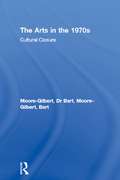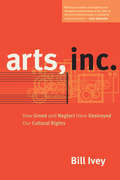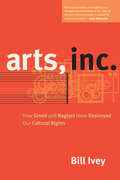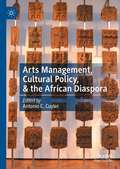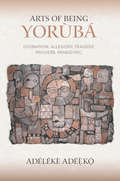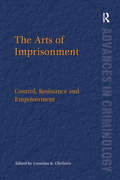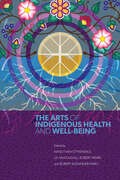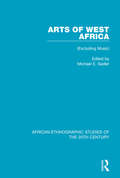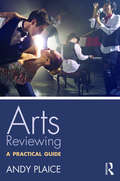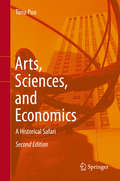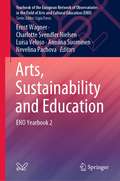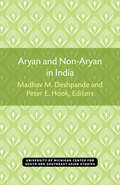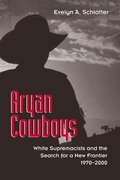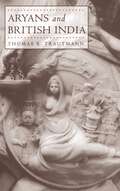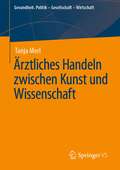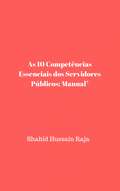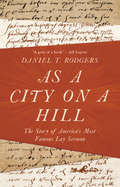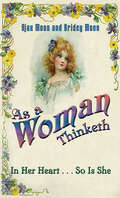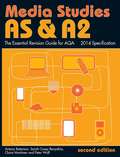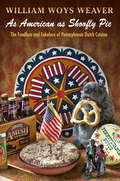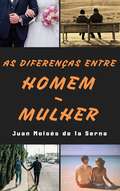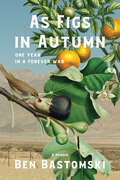- Table View
- List View
Arts in Place: The Arts, the Urban and Social Practice (Routledge Research in Culture, Space and Identity)
by Cara CourageThis interdisciplinary book explores the role of art in placemaking in urban environments, analysing how artists and communities use arts to improve their quality of life. It explores the concept of social practice placemaking, where artists and community members are seen as equal experts in the process. Drawing on examples of local level projects from the USA and Europe, the book explores the impact of these projects on the people involved, on their relationship to the place around them, and on city policy and planning practice. Case studies include Art Tunnel Smithfield, Dublin, an outdoor art gallery and community space in an impoverished area of the city; The Drawing Shed, London, a contemporary arts practice operating in housing estates and parks in Walthamstow; and Big Car, Indianapolis, an arts organisation operating across the whole of this Midwest city. This book offers a timely contribution, bridging the gap between cultural studies and placemaking. It will be of interest to scholars, students and practitioners working in geography, urban studies, architecture, planning, sociology, cultural studies and the arts.
The Arts in the 1970s: Cultural Closure
by Bart Moore-Gilbert Dr Bart Moore-GilbertWere the 1970s really `the devils decade'? Images of strikes, galloping inflation, rising unemployment and bitter social divisions evoke a period of unparalleled economic decline, political confrontation and social fragmentation. But how significant were the pessimism and self-doubt of the 1970s, and what was the legacy of its cultural conflicts? Covering the entire spectrum of the arts - drama, television, film, poetry, the novel, popular music, dance, cinema and the visual arts - The Arts in the 1970s challenges received perceptions of the decade as one of cultural decline. The collection breaks new ground in providing the first detailed analysis of the cultural production of the decade as a whole, providing an invaluable resource for all those involved in cultural, media and communications studies.
Arts, Inc.: How Greed and Neglect Have Destroyed Our Cultural Rights
by Bill IveyIn this impassioned and persuasive book, Bill Ivey, the former chairman of the National Endowment for the Arts, assesses the current state of the arts in America and finds cause for alarm. Even as he celebrates our ever-emerging culture and the way it enriches our lives here at home while spreading the dream of democracy around the world, he points to a looming crisis. The expanding footprint of copyright, an unconstrained arts industry marketplace, and a government unwilling to engage culture as a serious arena for public policy have come together to undermine art, artistry, and cultural heritage--the expressive life of America. In eight succinct chapters, Ivey blends personal and professional memoir, policy analysis, and deeply held convictions to explore and define a coordinated vision for art, culture, and expression in American life.
Arts, Inc.: How Greed and Neglect Have Destroyed Our Cultural Rights
by Bill IveyIn this impassioned and persuasive book, Bill Ivey, the former chairman of the National Endowment for the Arts, assesses the current state of the arts in America and finds cause for alarm. Even as he celebrates our ever-emerging culture and the way it enriches our lives here at home while spreading the dream of democracy around the world, he points to a looming crisis. The expanding footprint of copyright, an unconstrained arts industry marketplace, and a government unwilling to engage culture as a serious arena for public policy have come together to undermine art, artistry, and cultural heritage—the expressive life of America. In eight succinct chapters, Ivey blends personal and professional memoir, policy analysis, and deeply held convictions to explore and define a coordinated vision for art, culture, and expression in American life.
Arts Management, Cultural Policy, & the African Diaspora
by Antonio C. CuylerThis book centers people of African descent as cultural leaders to challenge the myth that they do not know how or care about managing and preserving their culture. Arts Management, Cultural Policy, & the African Diaspora also presents comparative case studies of the challenges, differences, similarities, and successes in approaches to cultural leadership across multiple cultural contexts throughout the diaspora. This volume disrupts the enduring and systemic global marginalization, oppression, and subjugation that threatens and undermines people of African descent’s cultural contributions to humanity. The most important distinguishing feature of the volume is its geographical use of the African diaspora to explore the subjects of arts management and cultural policy which, to date, no volume has done before. Furthermore, the volume’s comparative examination of ten critical, historical, practical, and theoretical questions makes it a significant contribution to the literatures in Arts Management, Cultural Policy, Cultural, Africana, African American, and Ethnic studies.
The Arts Management Handbook: New Directions for Students and Practitioners
by Constance DeVereaux Meg BrindleWhether the art form is theater, dance, music, festival, or the visual arts and galleries, the arts manager is the liaison between the artists and their audience. Bringing together the insights of educators and practitioners, this groundbreaker links the fields of management and organizational management with the ongoing evolution in arts management education. It especially focuses on the new directions in arts management as education and practice merge. It uses cases studies as both a pedagogical tool and an integrating device. Separate sections cover Performing and Visual Arts Management, Arts Management Education and Careers, and Arts Management: Government, Nonprofits, and Evaluation. The book also includes a chapter on grants and raising money in the arts.
Arts of Being Yoruba: Divination, Allegory, Tragedy, Proverb, Panegyric
by Adélékè AdéèkóThere is a culturally significant way of being Yorùbá that is expressed through dress, greetings, and celebrations—no matter where in the world they take place. Adélékè Adék documents Yorùbá patterns of behavior and articulates a philosophy of how to be Yorùbá in this innovative study. As he focuses on historical writings, Ifá divination practices, the use of proverbs in contemporary speech, photography, gendered ideas of dressing well, and the formalities of ceremony and speech at celebratory occasions, Adéékó contends that being Yorùbá is indeed an art and Yorùbá-ness is a dynamic phenomenon that responds to cultural shifts as Yorùbá people inhabit an increasingly globalized world.
The Arts of Imprisonment: Control, Resistance and Empowerment (New Advances in Crime and Social Harm)
by Leonidas K. CheliotisThe arts - spanning the visual, design, performing, media, musical, and literary genres - constitute an alternative lens through which to understand state-sanctioned punishment and its place in public consciousness. Perhaps this is especially so in the case of imprisonment: its nature, its functions, and the ways in which these register in public perceptions and desires, have historically and to some extent inherently been intertwined with the arts. But the products of this intertwinement have by no means been constant or uniform. Indeed, just as exploring imprisonment and its public meanings through the lens of the arts may reveal hitherto obscured instances of social control within or outside prisons, so too it may uncover a rich and possibly inspirational archive of resistance to them. This edited collection sheds light both on state use of the arts for the purposes of controlling prisoners and the broader public, and the use made of the arts by prisoners and portions of the broader public as tools of resistance to penal states. The book also includes a number of chapters that address arts-in-prisons programmes, making distinctive contributions to the literature on their philosophy, formation, operation, effectiveness, and research evaluation, as well as taking care to explore the politics surrounding and underpinning these multiple themes.
The Arts of Indigenous Health and Well-Being
by Edited by Nancy Van Styvendale;J.D. McDougall;Robert Henry;and Robert Alexander InnesDrawing attention to the ways in which creative practices are essential to the health, well-being, and healing of Indigenous peoples, The Arts of Indigenous Health and Well-Being addresses the effects of artistic endeavour on the “good life”, or mino-pimatisiwin in Cree, which can be described as the balanced interconnection of physical, emotional, spiritual, and mental well-being. In this interdisciplinary collection, Indigenous knowledges inform an approach to health as a wider set of relations that are central to well-being, wherein artistic expression furthers cultural continuity and resilience, community connection, and kinship to push back against forces of fracture and disruption imposed by colonialism. The need for healing—not only individuals but health systems and practices—is clear, especially as the trauma of colonialism is continually revealed and perpetuated within health systems. The field of Indigenous health has recently begun to recognize the fundamental connection between creative expression and well-being. This book brings together scholarship by humanities scholars, social scientists, artists, and those holding experiential knowledge from across Turtle Island to add urgently needed perspectives to this conversation. Contributors embrace a diverse range of research methods, including community-engaged scholarship with Indigenous youth, artists, Elders, and language keepers. The Arts of Indigenous Health and Well-Being demonstrates the healing possibilities of Indigenous works of art, literature, film, and music from a diversity of Indigenous peoples and arts traditions. This book will resonate with health practitioners, community members, and any who recognize the power of art as a window, an entryway to access a healthy and good life.
Arts of Living on a Damaged Planet: Ghosts and Monsters of the Anthropocene
by Anna Lowenhaupt Tsing Elaine Gan Heather Anne Swanson Nils BubandtLiving on a damaged planet challenges who we are and where we live. This timely anthology calls on twenty eminent humanists and scientists to revitalize curiosity, observation, and transdisciplinary conversation about life on earth.As human-induced environmental change threatens multispecies livability, Arts of Living on a Damaged Planet puts forward a bold proposal: entangled histories, situated narratives, and thick descriptions offer urgent &“arts of living.&” Included are essays by scholars in anthropology, ecology, science studies, art, literature, and bioinformatics who posit critical and creative tools for collaborative survival in a more-than-human Anthropocene. The essays are organized around two key figures that also serve as the publication&’s two openings: Ghosts, or landscapes haunted by the violences of modernity; and Monsters, or interspecies and intraspecies sociality. Ghosts and Monsters are tentacular, windy, and arboreal arts that invite readers to encounter ants, lichen, rocks, electrons, flying foxes, salmon, chestnut trees, mud volcanoes, border zones, graves, radioactive waste—in short, the wonders and terrors of an unintended epoch.Contributors: Karen Barad, U of California, Santa Cruz; Kate Brown, U of Maryland, Baltimore; Carla Freccero, U of California, Santa Cruz; Peter Funch, Aarhus U; Scott F. Gilbert, Swarthmore College; Deborah M. Gordon, Stanford U; Donna J. Haraway, U of California, Santa Cruz; Andreas Hejnol, U of Bergen, Norway; Ursula K. Le Guin; Marianne Elisabeth Lien, U of Oslo; Andrew Mathews, U of California, Santa Cruz; Margaret McFall-Ngai, U of Hawaii, Manoa; Ingrid M. Parker, U of California, Santa Cruz; Mary Louise Pratt, NYU; Anne Pringle, U of Wisconsin, Madison; Deborah Bird Rose, U of New South Wales, Sydney; Dorion Sagan; Lesley Stern, U of California, San Diego; Jens-Christian Svenning, Aarhus U.
Arts of West Africa: (Excluding Music) (Black Heritage Library Collection)
by Michael E. SadlerOriginally published in 1935, the aim of this book was to introduce the European to the art of West Africa. Many of the examples (extensively illustrated with black and white photos are from the regions between Senegal and Angola, primarily from Gambia, Sierra Leone, the Gold Coast, Nigeria and the Cameroons. Although the art and sculpture of West Africa is coherent, there are tribal and territorial characteristics which are discussed as is the significance of masks in ritual ceremony.
Arts Reviewing: A Practical Guide
by Andy PlaiceArts Reviewing: A Practical Guide is an accessible introduction to the world of arts criticism. Drawing on professional expertise and a range of cultural reviews from music, film, theatre, visual arts, television and books, Andy Plaice discusses different approaches to arts criticism, with tips on crafting great reviews. Chapters explore: • a brief history of arts criticism; • researching and preparing for an assignment; • legal and ethical boundaries when reviewing; • finding your own writing style; • starting and sustaining a career in arts criticism in the digital age. The book is underpinned by over 20 interviews with leading practitioners from across Britain, America and Australia. They offer fascinating insights into the life of a critic, including their best and worst career moments and the debates impacting the field of arts criticism. Interviewees include Neil McCormick, rock critic at the Daily Telegraph, the Guardian theatre critic Lyn Gardner and television critic Mark Lawson (BBC/ the Guardian). New approaches to reviewing techniques and writing style are combined with real-world advice from leading professionals in the field, making this book an ideal resource for students and graduates of journalism, cultural studies and media studies.
Arts, Sciences, and Economics: A Historical Safari
by Tönu PuuThis book deals with the economic aspects of changing attitudes in arts and sciences. The effects of the public good character of culture, along with the very long production period and lifetime for its products, are emphasized, since both contribute to the failure of normal market solutions. Embodiment of ideas and the consequences of modern reproduction technology for protection of property rights are closely examined. The evolution within arts and sciences, which often seems to return to previously scrapped ideals, is illustrated by detailed case studies, in which the importance of changing tastes, rather than progress proper, is emphasized. The author attempts an understanding for this using Darwinian evolution in combination with modern mathematical complexity theory, expressed in terms accessible to the general reader. The second edition is extended and updated especially as regards the illustration material.
Arts, Sustainability and Education: ENO Yearbook 2 (Yearbook of the European Network of Observatories in the Field of Arts and Cultural Education (ENO))
by Luísa Veloso Charlotte Svendler Nielsen Ernst Wagner Anniina Suominen Nevelina PachovaThis book explores the potential of arts and cultural education to contribute to on-going efforts to promote Education for Sustainable Development (ESD) in line with UNESCO’s conceptualizations of the field. It builds on the experiences of arts educators working to build sustainable futures and portrays new and innovative approaches. Chapters comprise case studies that combine arts, culture, sustainable thinking and practices. They also include research from historical perspectives, evaluations of public policy measures and offer theoretical approaches and methodologies. The book unfolds the possible relationships between arts and cultural education and Education for Sustainable Development.
Aryan and Non-Aryan in India (Michigan Papers On South And Southeast Asia #14)
by Madhav M. Deshpande Peter Edwin HookThe history and mechanisms of the convergence of ancient Aryan and non-Aryan cultures has been a subject of continuing fascination in many fields of Indology. The contributions to Aryan and Non-Aryan in India are the fruit of a conference on that topic held in December 1976 at the University of Michigan, Ann Arbor, under the auspices of the Center for South and Southeast Asian Studies. The express object of the conference was to examine the latest findings from a variety of disciplines as they relate to the formation and integration of a unified Indian culture from many disparate cultural and ethnic elements.
Aryan Cowboys: White Supremacists and the Search for a New Frontier, 1970-2000
by Schlatter Evelyn AEvelyn Schlatter's startling analysis describes how many of the new white supremacist groups in the West have co-opted the region's mythology and environment based on longstanding beliefs about American character and Manifest Destiny to shape an organic, home-grown movement.
Aryans and British India
by Thomas R. Trautmann"Aryan," a word that today evokes images of racial hatred and atrocity, was first used by Europeans to suggest bonds of kinship, as Thomas Trautmann shows in his far-reaching history of British Orientalism and the ethnology of India. When the historical relationship uniting Sanskrit with the languages of Europe was discovered, it seemed clear that Indians and Britons belonged to the same family. Thus the Indo-European or Aryan idea, based on the principle of linguistic kinship, dominated British ethnological inquiry.In the nineteenth century, however, an emergent biological "race science" attacked the authority of the Orientalists. The spectacle of a dark-skinned people who were evidently civilized challenged Victorian ideas, and race science responded to the enigma of India by redefining the Aryan concept in narrowly "white" racial terms. By the end of the nineteenth century, race science and Orientalism reached a deep and lasting consensus in regard to India, which Trautmann calls "the racial theory of Indian civilization," and which he undermines with his powerful analysis of colonial ethnology in India. His work of reassessing British Orientalism and the Aryan idea will be of great interest to historians, anthropologists, and cultural critics.
Ärztliches Handeln zwischen Kunst und Wissenschaft (Gesundheit. Politik - Gesellschaft - Wirtschaft)
by Tanja MerlAls vermeintlich selbstverständlicher Bestandteil der ärztlichen Tätigkeit ist die ‚ärztliche Kunst’ ein scheinbar vertrautes Phänomen, das im Alltagsverständnis auf allgemeine Akzeptanz stößt. Erst auf den zweiten Blick eröffnen sich Unklarheiten und Ambivalenzen. Eine substantielle Auseinandersetzung mit dem Begriff, seinen Implikationen und seines Stellenwerts - erst recht unter den gewandelten Bedingungen einer verwissenschaftlichten, technisierten und ökonomisierten Medizin - fehlt bislang. Durch die arbeitssoziologische Analyse können grundlegende Elemente der ‚ärztlichen Kunst’ empirisch präzisiert und handlungstheoretisch fundiert sowie ihre Bedeutung im Rahmen gegenwärtigen ärztlichen Handelns aufgezeigt werden.
As 10 Competências Essenciais dos Servidores Públicos: Manual
by Shahid Hussain RajaSer um servidor público é uma honra e um privilégio por um lado, mas uma grande responsabilidade pelo outro. O fiel cumprimento de seus deveres exige que você seja muito efetivo na prestação de serviços, eficiente na execução e honesto em seu trato com o público. Este pequeno manual é uma tentativa de listar as competências que podem ajudá-lo a se transformar. Felizmente, todas estas competências das quais você precisará enquanto desempenha as suas tarefas, podem ser aprendidas e não são herdadas. Apenas exige um compromisso incondicional e esforços dedicados para aprendê-las.
As a City on a Hill: The Story of America's Most Famous Lay Sermon
by Daniel T. RodgersHow an obscure Puritan sermon came to be seen as a founding document of American identity and exceptionalism“For we must consider that we shall be as a city upon a hill,” John Winthrop warned his fellow Puritans at New England’s founding in 1630. More than three centuries later, Ronald Reagan remade that passage into a timeless celebration of American promise. How were Winthrop’s long-forgotten words reinvented as a central statement of American identity and exceptionalism? In As a City on a Hill, leading American intellectual historian Daniel Rodgers tells the surprising story of one of the most celebrated documents in the canon of the American idea. In doing so, he brings to life the ideas Winthrop’s text carried in its own time and the sharply different yearnings that have been attributed to it since.As a City on a Hill shows how much more malleable, more saturated with vulnerability, and less distinctly American Winthrop’s “Model of Christian Charity” was than the document that twentieth-century Americans invented. Across almost four centuries, Rodgers traces striking shifts in the meaning of Winthrop’s words—from Winthrop’s own anxious reckoning with the scrutiny of the world, through Abraham Lincoln’s haunting reference to this “almost chosen people,” to the “city on a hill” that African Americans hoped to construct in Liberia, to the era of Donald Trump.As a City on a Hill reveals the circuitous, unexpected ways Winthrop’s words came to lodge in American consciousness. At the same time, the book offers a probing reflection on how nationalism encourages the invention of “timeless” texts to straighten out the crooked realities of the past.
As a Woman Thinketh: In Her Heart... So Is She
by Ajax MoonMike Pauro, aka 'Ajax Moon' and his daughter, Morgan Deeble, aka 'Bridey Moon' remake the aphorism examined by James Allen for women. In this transposition of Allen's classic, the authors revisit the impact of thought on health, purpose, achievement, ideas, and serenity from the female perspective. The work is accompanied by imagery from early 20th century postcards passed down for generations in their family. The images were selected to be contemporaneous of the era of James Allen (1864-1912).
AS & A2 Media Studies: The Essential Revision Guide For Aqa (Essentials)
by Antony Bateman Sarah Casey Benyahia Claire Mortimer Peter WallAS & A2 Media Studies: The Essential Revision Guide for AQA is a comprehensively updated new edition offering advice and guidance to help students pass AS and A2 Media Studies. Written by a team of experienced teachers and examiners, the book offers clear and engaging pathways through all the areas covered in the Media Studies curriculum, providing students with: • Revision Activities • Exam Tips and reminders • Definitions of key terms • Past paper questions • References to examiners reports. The authors also offer essential background information to help Media Studies students understand wider contexts and theoretical perspectives, as well as giving the lowdown on how exams are marked, how to manage self-study and approaching final examinations.
As American as Shoofly Pie
by William Woys WeaverWhen visitors travel to Pennsylvania Dutch Country, they are encouraged to consume the local culture by way of "regional specialties" such as cream-filled whoopie pies and deep-fried fritters of every variety. Yet many of the dishes and confections visitors have come to expect from the region did not emerge from Pennsylvania Dutch culture but from expectations fabricated by local-color novels or the tourist industry. At the same time, other less celebrated (and rather more delicious) dishes, such as sauerkraut and stuffed pork stomach, have been enjoyed in Pennsylvania Dutch homes across various localities and economic strata for decades.Celebrated food historian and cookbook writer William Woys Weaver delves deeply into the history of Pennsylvania Dutch cuisine to sort fact from fiction in the foodlore of this culture. Through interviews with contemporary Pennsylvania Dutch cooks and extensive research into cookbooks and archives, As American as Shoofly Pie offers a comprehensive and counterintuitive cultural history of Pennsylvania Dutch cuisine, its roots and regional characteristics, its communities and class divisions, and, above all, its evolution into a uniquely American style of cookery. Weaver traces the origins of Pennsylvania Dutch cuisine as far back as the first German settlements in America and follows them forward as New Dutch Cuisine continues to evolve and respond to contemporary food concerns. His detailed and affectionate chapters present a rich and diverse portrait of a living culinary practice--widely varied among different religious sects and localized communities, rich and poor, rural and urban--that complicates common notions of authenticity.Because there's no better way to understand food culture than to practice it, As American as Shoofly Pie's cultural history is accompanied by dozens of recipes, drawn from exacting research, kitchen-tested, and adapted to modern cooking conventions. From soup to Schnitz, these dishes lay the table with a multitude of regional tastes and stories.Hockt eich hie mit uns, un esst eich satt--Sit down with us and eat yourselves full!
As Diferenças entre Homem-Mulher
by Juan Moises de la Serna Claudio VazPara falar de diferenças homem-mulher é preciso começar pela genética, pois sobre esta base que se sustentam as diferenças posteriores. O ser humano contém 23 pares de cromossomos (unidades onde se empacotam o DNA e o RNA). O RNA porta a informação genética relativa ao sexo, por isso se denomina cromossomo sexual. Existem dois tipos desses cromossomos, o X e o Y. A mulher sempre terá o X no óvulo, enquanto o homem pode ter X ou Y nos espermatozoides.
As Figs in Autumn: One Year In A Forever War
by Ben BastomskiA devastating loss turns into a quest for identity in this debut memoir of an American coming of age in the Israel Defense Forces. On the verge of graduating from college, Ben Bastomski is sent reeling by the tragic death of his childhood friend and classmate Avi, the victim of a drunk driving accident. The shocking event forces Ben to question everything about the randomness and meaning of life for the first time. In the fall of 2010, Ben begins his journey from student to sharpshooter when he flies to the Middle East and joins the Mahal, the Israel Defense Forces&’ program for overseas Jewish volunteers. As his service takes him from the Negev Desert to the Occupied Territories and the Gazan border, he makes his home on a southern kibbutz where he is accepted as family. Ben&’s military service and life in Israel will shape his future in ways that are still being realized. As Figs in Autumn is one man&’s account of a life-changing quest to find his true potential in the land of his heritage, where both body and soul are sustained by courage and community.

